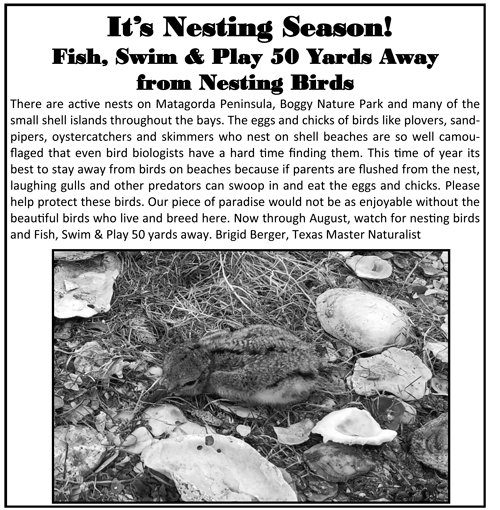
Fish, Swim & Play 50 Yards Away
Explore the Bay Paddling Series
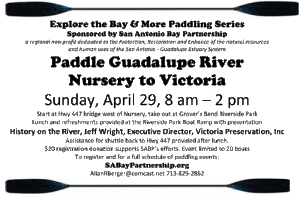
Upcoming Tournaments
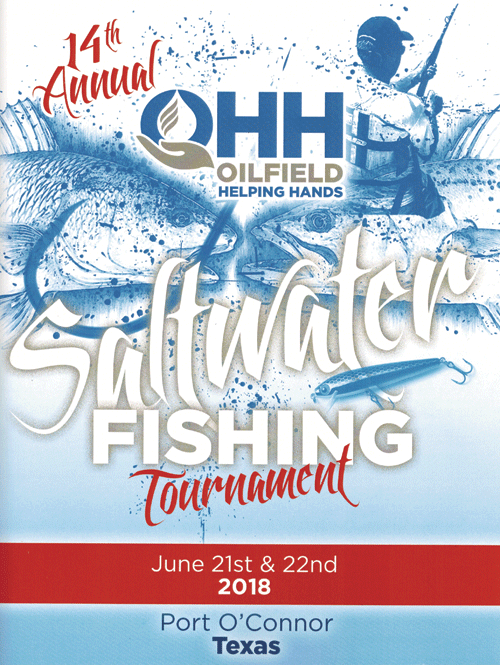
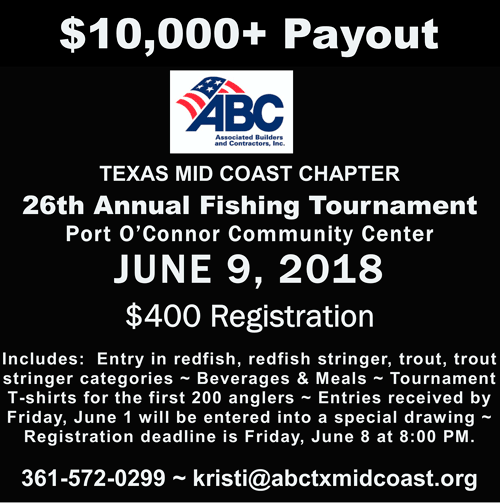
Locals Seek Boggy Improvements
Boggy Park was acquired by Calhoun County in 2006 “for a park and wetlands wildlife habitat; and for public access to Boggy Bayou and Matagorda Bay…” according to the transfer deed.
The Park is heavily used and currently shows the wear. As the community continues to grow, the pressures on it will only increase. Recognizing this, last June a citizens group sought and received Commissioners’ Court approval to develop ideas to protect and improve this outstanding community asset.
A nine-point improvement plan has been developed—and community comment and support are sought. The recommended improvements include:
1. Upgrading roads to Matagorda Bay shoreline and Boggy Bayou shoreline so that it is passable during wet conditions.
2. Converting access to the upland area to foot traffic with walking routes along an interpretive nature and birding trail.
3. Improving day use by installing additional picnic tables and restroom facilities.
4. Developing an outdoor environmental education area.
5. Seek inclusion in TPWD’s Great Texas Coastal Birding Trail and developing a bird watering and feeding station to enhance the habitat and bird viewing.
6. Seek inclusion in TPWD Texas Paddling Trial System as part of a “Powderhorn Ranch Shoreline Trail”.
7. Adding signage regarding Park rules, safety, and restrictions to illegal dumping.
8. Addressing shoreline erosion with groynes and beneficial use of dredge materials.
9. Improving security and surveillance to curtail inappropriate activities and use.
Additional details are available at sabaypartnership.org Programs. Comments, suggestions, and support is being sought. Please contact Allan Berger at allanrberger@comcast.net, or Brigid Berger, Kelly Gee or Troy Wygrs with your thoughts.
Based on the feedback from the community, the Plan will be revised as appropriate and presented to Commissioners’ Court. Once approved, the Plan will serve as the guiding document for implementation, a process that will most likely be accomplished in several steps as funding is obtained.
The planning committee believes the recommended improvements are necessary to protect and enhance the Park for its acquired purpose. The Plan will improve infrastructure to better handle that traffic, but ultimately, the committee is also asking for the community’s support in treading more lightly on the Park so that it is protected for all of us to enjoy.
Befriending The Marsh by Emma Shelly
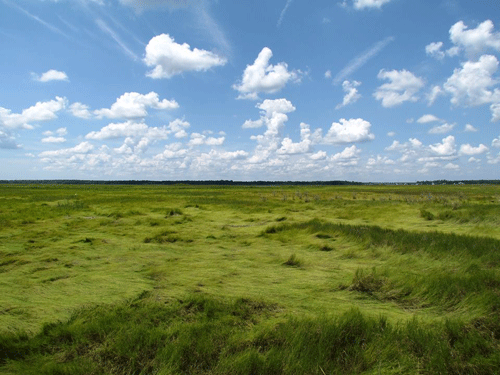
Marsh Photo by Becky Kern
Marshes and I didn’t get off to the best start.
In grad school I vividly remember springing out of our research canoe, taking my first step onto the saltmarsh I would be working in, and sinking knee-deep in mud. I didn’t even have a chance to react – the instant I put weight on that leg, down it went, sucked into wet, stinking muck. Adding insult to injury, that wasn’t even the worst part. The worst part came when I realized that there was no way I was pulling myself free without some leverage and leverage is hard to come by in a treeless expanse of swampland. In the end I surrendered the boot to the mud, flailed around on one leg while I tried to pull it free, gave up, planted both feet on the driest bit of marsh I could find and heaved on my shoe. Eventually the swamp gave it back.
Eventually.
I’d be lying if I said working in a marsh isn’t tough. There’s no shade, for one thing, and relatively no solid ground for another. So while you’re out there, pulling yourself across earth that’s sometimes more liquid than earthy, your sweating figure is a beacon for every kind of biting insect that lives in the area. Mosquitos and smaller biting flies quickly became lumped into the, “Eh what can you do” category but you never ignored a horsefly if you were lucky enough to see it before it bit you. They’re capable of going through fabric and they hurt if they got you, their scissoring mouthparts able to open up capillaries.
At the end of the day, sunburnt, covered in mud, itching from who-knows-what-bit-me, and stinking of sweat and swamp, it was safe to say that if I didn’t hate the marsh I certainly didn’t love it either. It was only the realization that my research project would keep me working in the marsh for at least 3 summers (and the fact that some awesome birds lived there) that convinced me that I needed to try and make friends with the ecosystem that had already tried to swallow me up.
Easier said than done, at first. I remember thinking, “There’s a reason no one goes into swamps,” as I grumpily waded across a flooded channel. People hike in woods, climb mountains, run across the beach, go for walks in the snow, but no one says to themselves, “Hey, let’s go for a stroll in the marsh this weekend.” And with good reason. They aren’t easily accessible places. They aren’t convenient places. At times, they can certainly be dangerous places. And when they do extend a cautious hand of “friendship” it’s subtle and up to you to notice.
At first, I didn’t even realize my resentment towards the saltmarsh was eroding. What I did notice, however, were more and more “snapshots” of imagery that struck me in the field and made me pause to take notice. Things like the iridescent mussels, opened wide and shinning in the mud. The young marsh succulents, growing out of the black muck, bright red at their bases and then bright green at the top. The high-pitched laugh-call of an osprey warning you off from its nesting platform and the flush of a willet, shooting startled from the grasses at your feet. I got to see horseshoe crabs for the first time ever – watching as the tides rose and they wandered in, cruising through the submerged landscape in their armored shells. I got to smell the ocean every day as it mixed with the estuary, the smell of salt mingling with the smell of algae. I saw both spectacular sunrises and sunsets out there and watched as the stars dotted the sky over all the quiet pools, flats, pannes, and channels that made up the pocked face of the marsh.
Images like these and more began to chip away one by one at my reservations but they did it so patiently and slowly that I didn’t even realize. I can’t even tell you when the turning point was other than to say there came a morning when I didn’t care that I had to wake up at 3 or that I would come home tracking dried mud. A time when I would willingly lose both boots to the mud if it meant I could find that one more sparrow nest or heck, even get close enough to get a good photo of one of the big dragonflies sunning itself on a driftwood log.
Don’t get me wrong. I understand why people don’t visit marshes. Everything I said about them being inaccessible, inconvenient, difficult, and dirty is true. But there’s more to them than that, it’s just that the “more” is buried like the mussels are buried: under a film of mud and water that rewards you for getting your hands dirty.
